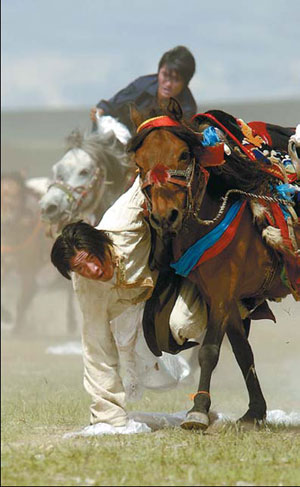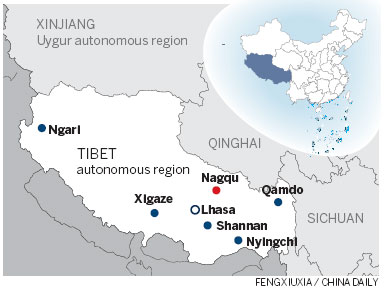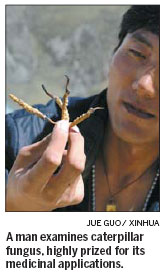Love for the high life
Updated: 2012-10-25 08:09
By Li Yao and Da Qiong (China Daily)
|
||||||||
Pilgrims retain traditions but modernity makes its presence felt, report Li Yao and Da Qiong in Nagqu prefecture, Tibet.
Exhausted and coated with dust, the Tibetan pilgrims move at a crawl and have a serene, determined look on their suntanned faces. Their solitude is rarely disturbed, except for the occasional passing vehicle and the fluttering of prayer flags.
In the sparsely populated land of Nagqu prefecture in the north of the Tibet autonomous region, their only companions are the rolling meadows and yak flocks spread like black pearls on the endless prairie - average elevation, 4,500 meters - complete with snowcapped mountains shimmering in the far distance.
Lhasa, the pilgrims' destination, is 326 km away as they undertake their once-in-a-lifetime journey. They clasp their hands and point in turn at the sky, their foreheads and chests, then stride forward, kneeling at every step before prostrating their bodies on the ground. Even their tough yak-skin clothes wear out quickly as they repeat the motions over and over.
Their handclaps follow a distinct rhythm, emphasized by wooden hand coverings that occasionally boast metal strips on the exterior. From October onward, the number of pilgrims rises as herding stops during winter, a long season dominated by severe cold, dry air and the rarified atmosphere. The harsh conditions also deter many visitors who fear altitude sickness with its severe headaches, nausea, loss of appetite and inability to sleep.
Herding lasts from June to October. Nagqu, an area of 420,000 square kilometers, is the region's largest prefecture and main grazing land. It has a population of 460,000.
The prefecture was the military base of the Tubo Kingdom in the seventh century. In 1269, Kublai Khan, who later founded the Yuan Dynasty (1271-1368), stationed his troops on the ancient postal routes, which now run through four of the 10 counties under the prefecture's jurisdiction. The name of one of the counties, Sog, means "Mongolian" in Tibetan and some residents are said to be descended from the fierce warriors.
Most of the prefecture is devoid of trees, but not for lack of trying. More than a decade ago, the authorities offered a large reward to anyone who could plant a tree capable of surviving the harsh conditions - so far, no one has been able to claim the cash.
Grasses also maintain a delicate existence here, spreading in a thin, fragile layer over the plateau. To keep their cattle sufficiently fed, the herdsmen migrate far and wide in search of fresh water and grazing land.
Herders live in black tents erected on riverbanks. Hand-woven from yak hair, the tents provide a warm shelter from the wind and rain, dry quickly in the sun after rain and snow, and are easy to pack for the next move.
The prefecture's annual horse racing festival is held every August. The grand occasion attracts people in their best outfits, performing stunts on horseback and participating in wrestling, dancing, singing, feasting and merrymaking.
 |
|
The annual horse racing festival, held in Nagqu, attracts people in their best outfits, performing stunts on horseback and participating in wrestling, dancing, singing and feasting. Wen Tao / Xinhua |
Sogru Bujog, 47, from Lhashi township in Baqen county, has three framed photos of himself at the festival in his living room. The clothes he wore at the festival cost 250,000 yuan ($40,000), equal to the cost of his house.
He has two sons and two daughters and the family lives in a two-story house built in 2006. Each room has a distinct function: Family members live in some, but others are reserved to receive guests, practice religion, store grain and house the family's 70 yaks.
Herders understand the need to keep the size of their herds manageable, in proportion to the number of working hands in the family. "It is definitely not a case of 'the more, the merrier,'" said Sogru Bujog.
His eldest son, aged 20, follows the herdsman's life, but his other son is learning to drive and plans to use that to make a living.
Caterpillar fungus
The prefecture is famous for caterpillar fungus, which, due to its rarity and perceived high medicinal value, has become an important source of income for many Tibetans.
Sogru Bujog made 150,000 yuan this year by selling the fungus. Although the family collected less than last year, it sold at a higher price, earning roughly the same amount as in 2011.
As village head, Sogru Bujog leads patrols aimed at preventing outsiders from collecting the fungus during May and June. Boundaries are clearly marked for each village, both for fungus collection and grazing land.
Driven by the strong demand from inland cities, the price of the fungus is high and it's considered a more dependable source of revenue than raising yaks, especially as the ruthless winters may kill large numbers of the animals and result in financial losses.
Although some villagers are concerned about a collapse in prices and resource exhaustion, this income stream has changed the lives and habits of many locals.
Sogru Bujog's elder brother lives in Nagqu town, home of the prefectural administration. He and his wife only return to their native village during the fungus-collection season and rely on the income made during those two months for the rest of the year.
Others make big bucks. The less frugal become loose with their money and develop expensive habits: gambling, living in hotels and eating in restaurants.
"Fungus collectors refuse to play mahjong with public servants, because of the wide disparity in income," said Sodnam Yutso, 26, who works for the Lhashi township government.
Born in a village about 10 km from Lhashi, she spent four years at junior high school in Liaoyang, Liaoning province, but didn't return home until graduation. She didn't go home during her three years at senior high school in Beijing, either. Finally, she majored in biological engineering at the Ocean University of China in Qingdao, Shandong province.
"I feel lucky because nothing drastic happened to my family when I was not around," she said. Her grandmother, who is more than 90 years of age, was worried they might never see each other again after the girl left home to attend school.
"My family didn't expect my education to take so long. All the people they know find work and settle down after primary or technical school," she said.
She lives in an apartment provided by the Lhashi government and visits her family on weekends. "It is a near-perfect situation. I have a private place and live not too far from home," she said. Her experiences in three different cities help her remain calm in difficult circumstances. In moments of triumph or failure, she simply looks back at how far she has traveled.
She is the oldest of six children. A 23-year-old sister and 20-year-old brother help with the herding at home and the others are still at school. Her closest sister by age will eventually marry a herdsman.

 Relief reaches isolated village
Relief reaches isolated village
 Rainfall poses new threats to quake-hit region
Rainfall poses new threats to quake-hit region
 Funerals begin for Boston bombing victims
Funerals begin for Boston bombing victims
 Quake takeaway from China's Air Force
Quake takeaway from China's Air Force
 Obama celebrates young inventors at science fair
Obama celebrates young inventors at science fair
 Earth Day marked around the world
Earth Day marked around the world
 Volunteer team helping students find sense of normalcy
Volunteer team helping students find sense of normalcy
 Ethnic groups quick to join rescue efforts
Ethnic groups quick to join rescue efforts
Most Viewed
Editor's Picks

|

|

|

|

|

|
Today's Top News
Health new priority for quake zone
Xi meets US top military officer
Japan's boats driven out of Diaoyu
China mulls online shopping legislation
Bird flu death toll rises to 22
Putin appoints new ambassador to China
Japanese ships blocked from Diaoyu Islands
Inspired by Guan, more Chinese pick up golf
US Weekly

|

|








